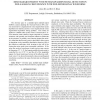Free Online Productivity Tools
i2Speak
i2Symbol
i2OCR
iTex2Img
iWeb2Print
iWeb2Shot
i2Type
iPdf2Split
iPdf2Merge
i2Bopomofo
i2Arabic
i2Style
i2Image
i2PDF
iLatex2Rtf
Sci2ools
ICASSP
2011
IEEE
2011
IEEE
MIMO radar diversity with Neyman-Pearson signal detection in non-Gaussian circumstance with non-orthogonal waveforms
The diversity gain of a multiple-input multiple-output (MIMO) system adopting the Neyman-Pearson (NP) criterion is derived for a signal-present versus signal-absent scalar hypothesis test statistic and for a vector signal-present versus signal-absent hypothesis testing problem. The results are applied to a MIMO radar system with M transmit and N receive antennas, used to detect a target composed of Q random scatterers with possibly non-Gaussian reflection coefficients in the presence of possibly non-Gaussian clutter-plus-noise. It is found that the diversity gain for the MIMO radar system is dependent on the cumulative distribution function (cdf) of the reflection coefficients while invariant to the cdf of the clutter-plus-noise under some reasonable conditions. If the noise-free received waveforms at each receiver span a space of dimension M ≤ M, the largest possible diversity gain is controlled by min (NM , Q) and the cdf of the magnitude square of a linear transformed version...
| Added | 21 Aug 2011 |
| Updated | 21 Aug 2011 |
| Type | Journal |
| Year | 2011 |
| Where | ICASSP |
| Authors | Qian He, Rick S. Blum |
Comments (0)

